![]()
![]()
![]()
Use LEFT and RIGHT arrow keys to navigate between flashcards;
Use UP and DOWN arrow keys to flip the card;
H to show hint;
A reads text to speech;
14 Cards in this Set
- Front
- Back
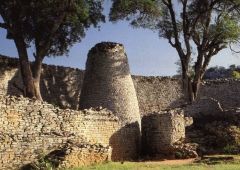
|
T: Conical tower and circular wall of Great Zimbabwe A: Shona peoples D: c. 1000-1400 C.E. M/T: Coursed granite blocks P/S: African OL: Southeastern Zimbabwe P: Unknown F: Meant to either be a Queen's Residence or a religious temple. DT: Stone wall C: Early human settlement |
|
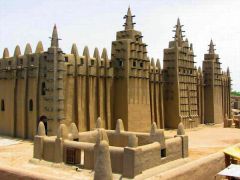
|
T: Great Mosque of Djenne A: Unknown D: c. 1200 C.E.; rebuild 1906-1907 M/T: Adobe P/S: African OL: Mali P: Unknown F: Commerce. Political symbol for locals DT: Mud bricks, religious worshipping C: Politicaly powerhouse, Islamic teaches during the Middle Ages |
|
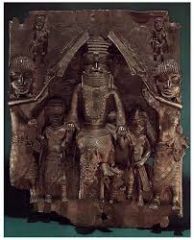
|
T: Wall plaque, from Oba's palace A: Edo peoples D: 16th century C.E. M/T: Cast brass P/S: African OL: Benin (NIgeria) P: Upper class F: Serve as a power and social status symbol DT: Engraving plaque, coral beaded regalia C: Depics a king and his attendants from the Benin Empire |
|
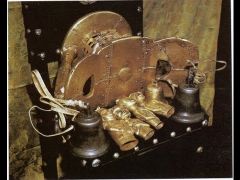
|
T: Sika dwa kofi (Golden Stool) A: Ashanti peoples D: c. 1700 C.E. M/T: Gold over wood and cast-gold attachments P/S: African OL: South Central Ghana P: Osei Tutu F: House the spirit of Ashanti Nation DT: Throne C: Sika Dawa Kofi is one of the items of regalia that encapsulates the Asante nation of statehood. |
|
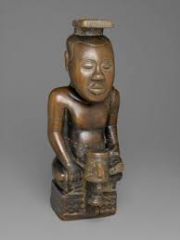
|
T: Ndop (portrait figure) of King Mishe miShyaang maMbul A: Kuba peoples D: c. 1760-1780 C.E. M/T: Wood P/S: African OL: Democratic Republic of the Congo P: A Kuba leader or Nyim F: TO preserve the Nyims' accomplishments for posterity DT: Geometric, carving, abstract, reprsentative, decorative C: It shows the King's symbol: a drum with a detached hand. The ruler is sitting cross legged. |
|

|
T: Power figure (Nkisi n'kondi) A: Kongo peoples D: Late 19th century C.E. M/T: Wood and metal P/S: African OL: Democratic Republic of the Congo P: Unknown F: Spirit catcher or voodoo doll DT: Abstract, inhuman C: Usually used as divine-protection/ commonly. |
|

|
T: Female (Pwo) mask A: Chokwe peoples D: Late 19th to early 20th century C.E. M/T: Wood, fiber, pigment, and metal P/S: African OL: Democratic Republic of the Congo P: Unknown F: Represents the ideal woman. It was made to honor women, particularly those who had sucessfully given birth DT: Matrineal, dance, graceful, respectful, honor C: Recognizes founding female ancestor of the Chokwe lineage. |
|
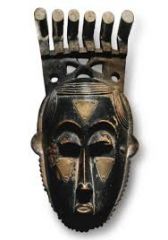
|
T: Portrait mask (Mblo) A: Baule peoples D: Early 20th century C.E. M/T: Wood and pigment P/S: African OL: Cote d'Ivoire P: Kouame Ziarey F: Entertainment, honor/respect member of Baule society DT: Oval face, elongated nose, small-open mouth C: Two types of entertainment maks. Mask were not to be hung and admired but to act/appreciation |
|
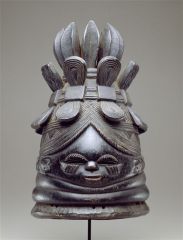
|
T: Bundu mask A: Sande Society, Mende peoples D: 19th to 20th century C.E. M/T: Wood, cloth, and fiber P/S: African OL: West African forests of Sierra Leone and Liberia P: Unknown F: Worn for initiation, to instruct young girls about proper womanhood DT: Little mouth, petite ears, high, glossy forehead, wild elaborate hair style, serious C: Downcast eyes suggest that she should be reserved. The small mouth suggest she should keep her mouth closed and not gossip. Small ears suggest not to listen to that gossip. Rolls of fat under chin suggest that she is full-figured and has enough body fat to be able to bear children. |
|
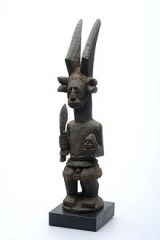
|
T: Ikenga (shrine figure) A: Igbo peoples D: c. 19th to 20th century C.E. M/T: Wood P/S: African OL: Nigeria P: Unknown F: Signify the achievements or abilities of their owners DT: Abstract, naturalistic,symbolism, ritual, and icon C: Right hand holds a sword, left hand holds a variety of items. Ikenga means "place of strength". |
|
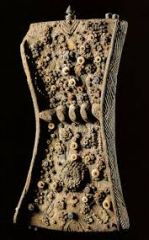
|
T: Lukasa (memory board) A: Mbudye Society, Luba peoples D: c. 19th to 20th century C.E. M/T: Wood, cloth, and fiber P/S: African OL: Democratic Republic of the Congo P: Unknown F: Serve as a memory aid that describes the myths surrounding the origins of the Luba empire DT: carving of relief, geometric designs, beading C: Each board’s design is based on what memories are important to the patron, a single colored bead = specific individual, a large bead surrounded by smaller ones = chief & his dignitaries, the lines of the beads represents a journey or path |
|
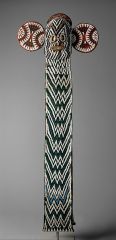
|
T: Aka elephant mask A: Bamileke D: c. 19th to 20th century C.E. M/T: Wood, woven raffia, cloth, and beads P/S: African OL: Cameroon, western grassfields region P: High ranking officials F: Honors the king, shows the power of the king DT: Mask, masquerade, symbol, C: Used in masquerades with costumes and performers and musicians that brought the mask to life |
|
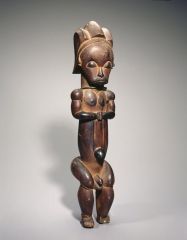
|
T: Reliquary figure (byeri) A: Fang peoples D: c. 19th to 20th century M/T: Wood P/S: African OL: Southern Cameroon P: Byeri F: The figure held great spiritual power, devoted to the veneration of lineage ancestors and people who made significant contributions to the community DT: Figure, honorable statue C: After death the relics were conserved cylindrical bark containers and were protected |
|
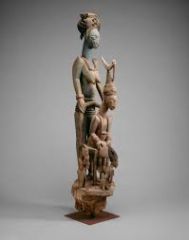
|
T: Veranda post of enthroned king and senior wife (Opo Ogoga) A: Olowe of Ise (Yoruba peoples) D: c. 1910-1914 M/T: Wood and pigment P/S: African OL: Africa P: Unknown F: To show a ruler's dependence on others DT: Linear motifs, exaggerated proportions C: One of four sculpted for the palace at Ikere by the renowned Yoruba artist Olowe of Ise. |

